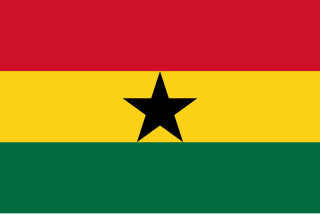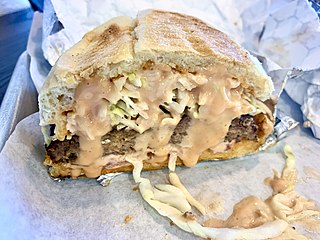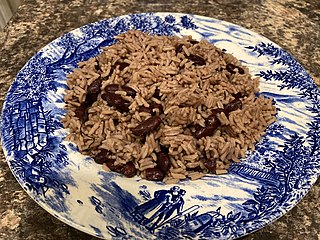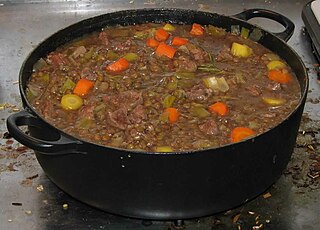
Puerto Rican cuisine consists of the cooking style and traditional dishes original to Puerto Rico. It has been primarily a fusion influenced by the ancestors of the Puerto Rican people: the indigenous Taínos, Spanish Criollos and sub-Saharan African slaves. As a territory of the United States, the culinary scene of Puerto Rico has also been moderately influenced by American cuisine.

Fried rice is a dish of cooked rice that has been stir-fried in a wok or a frying pan and is usually mixed with other ingredients such as eggs, vegetables, seafood, or meat. It is often eaten by itself or as an accompaniment to another dish. Fried rice is a popular component of East Asian, Southeast Asian and certain South Asian cuisines, as well as a staple national dish of Indonesia. As a homemade dish, fried rice is typically made with ingredients left over from other dishes, leading to countless variations. Fried rice first developed during the Sui dynasty in China.

Jamaican cuisine includes a mixture of cooking techniques, flavours and spices influenced by Amerindian, West African, Irish, English, French, Portuguese, Spanish, Indian, Chinese and Middle Eastern people who have inhabited the island. It is also influenced by indigenous crops, as well as, crops and livestock introduced to the island from Mesoamerica, Europe, tropical West Africa and Southeast Asia— which are now grown locally. A wide variety of seafood, tropical fruits and meats are available.

Rice and beans, or beans and rice, is a category of dishes from many cultures around the world, whereby the staple foods of rice and beans are combined in some manner. The grain and legume combination provides several important nutrients and many calories, and both foods are widely available. The beans are usually seasoned, while the rice may be plain or seasoned. The two components may be mixed together, separated on the plate, or served separately.

Hoppin' John, also known as Carolina peas and rice, is a rice and beans dish of legendary origins associated with the cuisine of the Southern United States. Similar dishes are found in regions with a significant African-origin demographic like Louisiana red beans and rice. The Carolina version is known for the addition of bacon and other kinds of pork.

Colombian cuisine is a culinary tradition of six main regions within Colombia. Colombian cuisine varies regionally and is influenced by Indigenous Colombian, Spanish, and African cuisines, with a slight Arab influence in some regions.

Ghanaian cuisine refers to the meals of the Ghanaian people. The main dishes of Ghana are centered around starchy staple foods, accompanied by either a sauce or soup as well as a source of protein. The primary ingredients for the vast majority of soups and stews are tomatoes, hot peppers, and onions. As a result of these main ingredients, most Ghanaian jollof rice, soups, and stews appear red or orange.

Dominican cuisine is made up of Spanish, Indigenous Taíno, Middle Eastern, and African influences. The most recent influences in Dominican cuisine are from the British West Indies and China.

Rice and peas or peas and rice is a traditional rice dish in some Caribbean and Latin American countries. Sometimes, the dish is made with pigeon peas, otherwise called gungo peas by Jamaicans. Kidney beans and other similar varieties are typically used in the Greater Antilles and coastal Latin America. Rice and peas recipes vary throughout the region, with each country having their own way(s) of making them and name(s)—with the two main ingredients being legumes and rice, combined with herbs, spices and/or coconut milk.

Most traditional foods in Guatemalan cuisine are based on Maya cuisine, with Spanish influence, and prominently feature corn, chilies and beans as key ingredients. Guatemala is famously home to the Hass avocado.

Javanese cuisine is the cuisine of Javanese people, a major ethnic group in Indonesia, more precisely the province of Central Java, Yogyakarta and East Java.

Red peas soup is a hearty Jamaican soup, made with kidney beans, cured meats, coconut milk, root vegetables, dumplings, herbs and spices like scotch bonnet, pimento, scallion etc. It is the soup version of Jamaican stew peas, and is similar to other red bean soups made in the Americas. The dish is served as an appetizer or main course. Like stew peas, red peas soup is rich in protein as the main ingredients are legumes and meats.
The Cayman Islands are a group of islands situated in the Caribbean Sea just between Cuba and Honduras. After being colonized first by Jamaica and then by the British, Cayman Islands remained under British dependency since 1962. Traditional Cayman Islands cuisine is very tied to Jamaican cuisine and they also kept British influences in their cooking, but you can as well find a large variety of international dishes with a local twist. As for traditional dishes the main ingredients are coconut, plantain, cassava, yams, rice and peas. Jamaican cuisine enriched Cayman’s cuisine by offering a large variety of spices such as jerk, curry and other exotic seasonings. The humid soil provides a large variety of exotic fruits and vegetables such as yellow squash, avocados, callaloo, cassava, calabash, spring onions, pineapples, tomatoes, peas, chili, peppers a great range of citrus fruits such as oranges, lemons, limes, grapefruits, bananas and plantains, sweet potatoes, yams and mangoes.

Run down, also referred to as rundown, run dun, rondón, fling-me-far, and fling mi for, is a stew dish in Jamaican cuisine and Tobago cuisine. The traditional Jamaican dish is eaten in several Latin American countries that share a coast with the Caribbean Sea.

A stew is a combination of solid food ingredients that have been cooked in liquid and served in the resultant gravy. Ingredients can include any combination of vegetables and may include meat, especially tougher meats suitable for slow-cooking, such as beef, pork, venison, rabbit, lamb, poultry, sausages, and seafood. While water can be used as the stew-cooking liquid, stock is also common. A small amount of red wine or other alcohol is sometimes added for flavour. Seasonings and flavourings may also be added. Stews are typically cooked at a relatively low temperature, allowing flavours to mingle.
























